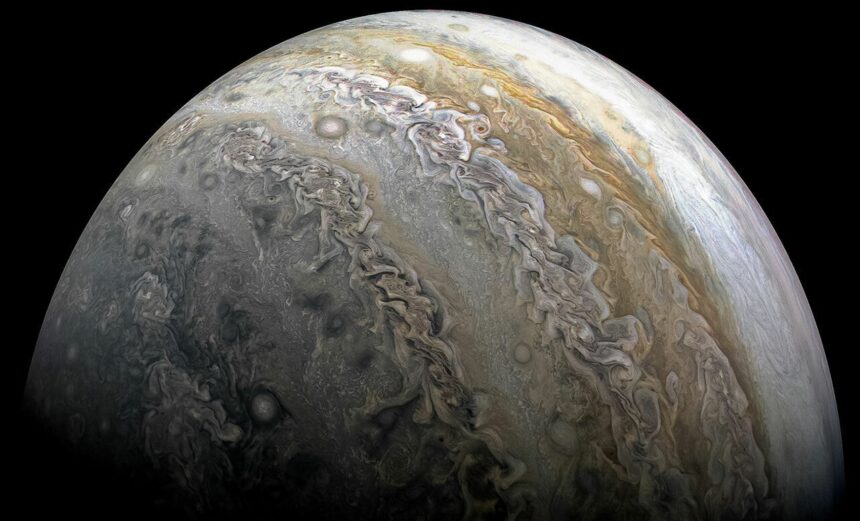In a captivating display, footage captured by a Japanese astronomer shows a high-speed object colliding with Jupiter. The video, posted on social media, reveals a bright flash as an asteroid or comet impacts the gas giant planet. While Jupiter regularly attracts collisions due to its size and gravitational pull, this particular event resulted in a small impact, producing a quick burst of light. The story of our solar system is one of collisions, and studying these events provides valuable insights into our cosmic neighborhood. Amateur astronomers around the world play a crucial role in observing and documenting such occurrences, contributing to our understanding of the universe.
High-speed object collides with Jupiter in captivating footage
On August 29, an amateur astronomer captured a stunning event on video: a high-speed object colliding with Jupiter. The footage, which was later posted on social media, showcases the impact and the subsequent burst of light on the gas giant. This captivating event has garnered attention and offers valuable insights into celestial collisions.
![]()
Event captured on August 29
The event took place on August 29, when the Japanese astronomer recorded the collision on video. The precise date and time of the collision were documented, allowing for further analysis and observations.
Amateur astronomer posts video on social media
The video was shared on X (formerly known as Twitter) by the account MASA Planetary Log. This social media platform provides a convenient and accessible means for sharing astronomical events and discoveries with a wide audience. The video quickly gained traction and captivated viewers with its remarkable footage.
Impact causes friction and heating up
When the high-speed object collided with Jupiter, it rapidly traversed the gas giant’s lofty sky. The collision with atmospheric molecules resulted in intense friction and rapid heating up of the object. This process caused the object to melt and explode, creating a visually stunning fireball.
Comparison to meteors on Earth
The phenomenon of meteors exploding in Earth’s atmosphere bears a striking resemblance to the collision on Jupiter. Just like meteors, the high-speed object experienced a rapid burst of light upon impact. This parallel offers valuable insights into the similarities between celestial collisions in different planetary environments.
Small impact event for Jupiter
Considering Jupiter’s immense size, the collision with the high-speed object was relatively small in magnitude. Similar to past collisions, such as the notable Comet Shoemaker-Levy 9 impact in 1994, this event only resulted in a quick burst of light. In contrast, larger collisions with Jupiter have caused dark splotches on its surface, with one impact leaving a mark equivalent to the diameter of Earth.
Previous large collisions on Jupiter
The collision with the high-speed object serves as a reminder of past significant collisions on Jupiter, such as the aforementioned Comet Shoemaker-Levy 9 impact. These collisions have left lasting marks on Jupiter’s surface, offering valuable scientific data and insights. The comparison in size between these collisions and Earth provides an understanding of the impact’s significance.
Quick burst of light
The collision between the high-speed object and Jupiter resulted in a brief but intense burst of light. The flash was vivid and caught the attention of astronomers and enthusiasts alike. Numerous social media posts capturing the event showcased the brilliant display, adding to the excitement surrounding the collision.
Continual collisions with Jupiter
Jupiter’s massive size and gravitational pull make it an attractive celestial body for objects in space. With almost 100 known moons, the largest planet in our solar system acts as a magnet for numerous objects. The analogy of Jupiter being a giant vacuum cleaner in the solar system emphasizes its ability to attract and interact with various objects in its vicinity. This continual interaction leads to frequent collisions with Jupiter, offering astronomers a unique perspective on these high-speed events.
Jupiter’s attraction of objects
Jupiter’s gravitational force plays a crucial role in attracting objects and debris from its surroundings. Its immense size and mass create a gravitational pull that draws in nearby objects and increases the likelihood of collisions. The presence of numerous moons further contributes to Jupiter’s attraction, forming a complex and dynamic system within the Jovian environment.
Objects hitting Earth
While Jupiter experiences frequent collisions, Earth also encounters its fair share of celestial impacts. On a daily basis, approximately 100 tons of dust and sand-sized particles fall through Earth’s atmosphere, burning up upon entry. Additionally, larger impacts occur on longer timescales, with objects around 460 feet in diameter colliding with Earth every 10,000 to 20,000 years. The infrequent but significant “dinosaur-killing” impacts occur on timescales of 100 million years. The study of these impacts and NASA’s exploration of impact sizes and frequencies contribute to the development of planetary defense strategies.
In conclusion, the recent collision between a high-speed object and Jupiter, captured on video and shared on social media, provides valuable insights into celestial collisions. This small impact event serves as a reminder of Jupiter’s ability to attract objects, while also highlighting the frequency of collisions within our solar system. By studying these events, astronomers can deepen their understanding of the cosmos and enhance our knowledge of celestial bodies and their interactions.
Source: https://mashable.com/article/jupiter-collision-space-asteroid
